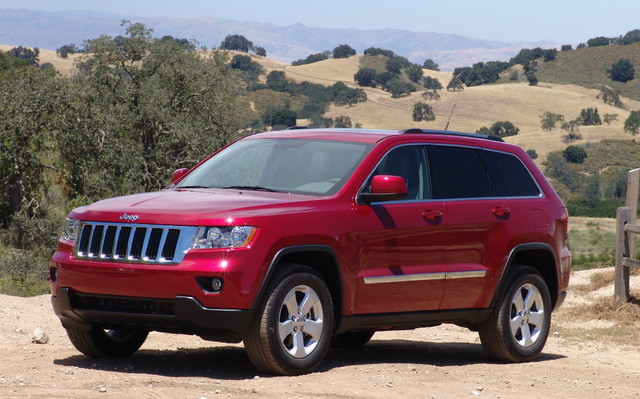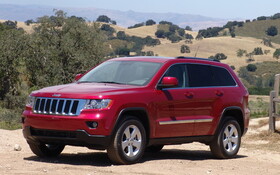2011 Jeep Grand Cherokee: All-terrain back on familiar terrain
The Jeep Grand Cherokee arrived on the market in 1993, and since then it has built an enviable reputation as a tireless adventurer and champion of comfort. At that time, and it wasn’t very long ago, it was also known for its mechanical breakdowns and chronic gas guzzling...
The Jeep Grand Cherokee was due for major changes several years ago, but Chrysler’s financial difficulties put things on hold. After parading it from car show to car show, where it played little more than a bit part, Jeep is finally presenting its new flagship.
Somewhat ordinary style
On the outside, the new Jeep Grand Cherokee isn’t all that different from its ancestor. There’s Jeep’s beloved seven-vertical-bar chrome front grille and square angles – everything is reminiscent of the old generation. Clearly, the designers must have been on drugs... Not that it’s ugly, far from it. However, its style is rather ordinary, unlike the Infiniti FX which, in my humble opinion, goes overboard. The folks at Jeep spent a lot of time during the presentation explaining every little rod, bulge and eye-catching line... On the other hand, the designers managed to modernize its classic lines known around the world without taking away its identity. And kudos to them for doing it...
In the passenger compartment, the changes are less subtle and long overdue. The look is modern, as is the quality and assembly of the materials. Sure, there are still some hard plastics, in particular on the lower part of the dashboard and the doors, but most of the surfaces are pleasant to the touch. All of the versions have a height adjustable telescopic steering wheel but I found it a little too thick, but that didn’t seem to bother the others who tested it. Most of the buttons are in the right place, but the gauges, which aren’t particularly easy to read because of the glare, get a D. God bless them though, it sure is fully loaded. For example, the base model, the Laredo E, has heated front seats, remote keyless entry and Start/Stop button, Sirius satellite radio, dual-zone climate control, etc.
There’s no shortage of space and the seats, even in the base version, are comfortable. In back, except in the middle seat, even the most sensitive derrieres are handled with care and the highest of heads and most disproportionately long of legs won’t have trouble finding room. Jeep answered the old model’s harshest critics by making the new Grand Cherokee’s chassis 135 mm (5.3 inches) longer, and the passengers in the back seats are reaping the benefits. As for the trunk, it’s 19% bigger than before. I don’t know how Jeep’s engineers calculate it, but if you take the old data (between 978 and 1,909 litres depending on whether the seatbacks are raised or lowered) and add 19%, you get 1,163 and 2,195 litres. Jeep’s figures are 990 and 1,950… So as we were saying, the Grand Cherokee’s trunk is bigger than before...
Modern chassis and V6
Four versions of the Jeep Grand Cherokee are offered to Canadian clients. The Laredo E, as we just mentioned, is the entry level model, followed by the Laredo X, the Limited and the Overland. Although the equipment increases exponentially with each version, the aesthetic differences are not very obvious. This characteristic may not make everyone happy, particularly those who absolutely want their Overland to be noticed…
It has already been several years since Chrysler introduced new products. A little like a person who has been deprived of going to a restaurant for too long and then buys the best table in the city after winning a little money in the lottery, Jeep’s engineers got a hold of the Mercedes-Benz ML-Class’ chassis to devise their Grand Cherokee. At that time, the two manufacturers still had a good relationship. Again, the wheelbase gained precious inches, but now this Jeep is rigid and refined like no other Jeep we’ve ever seen.
The Grand Cherokee’s specs sheet is headlined by two engines: a V6 and a V8. The honchos at Chrysler Canada believe that the engines will share the market equally. The 3.6-litre V6 Pentastar is brand new, and should also be used in several Chrysler-Dodge-Jeep products very soon. Its 290 horses and 260 lbs-ft of torque are delivered directly and it should meet most needs. Expect 13 litres/100 km in town and 8.9 on the highway, which is still quite high. Performance enthusiasts will recognize the 5.7-litre V8 Hemi. Strangely, its 360 horses and 390 lbs-foot of torque are not delivered in spectacular fashion. Sure, its 0-100 km/hr time is two seconds less with the V8 (about 8.7 seconds), but you don’t feel the boost that you’d expect to feel. Its main quality remains its increased towing capacity.
Not surprisingly, it consumes more gas, some 15.7 litres/100 km in town, and 10.6 on the highway. Of course, the sound of the V8 in acceleration is more pleasant than the V6 (which isn’t too shabby either!). In Québec, we’re saddened by the absence of the diesel engine that was retired in 2009 after only two years of loyal service. The bigwigs at Jeep decided that this engine wasn’t necessary any more, since the current V6 offers the same fuel economy. What about the towing capacity, you ask? In a nutshell, the V6 can tow up to 5,000 pounds (2,269 kilos) while the V8 tows up to 7,200 pounds (3,300 kilos). These are excellent figures, but unfortunately, we weren’t able to drive a Grand Cherokee with a heavy trailer at the launch.
It has a five-speed automatic transmission, which makes us think that after purchasing a decent chassis and creating a new engine, there wasn’t much money left to spend on this important feature. Say what you will about it, this transmission runs smoothly and seems well adapted to both engines.
95% of people will never use it…
If any self-respecting Jeep has a decent 4x4 system, then the Grand Cherokee really respects itself... The Laredo E and X will have the Quadra-Trac I all-wheel drive that doesn’t require any intervention from the driver and can send up to 50% of the torque to the front wheels when the need arises. Most people will prefer the Quadra-Trac II however, which is much more off-road oriented. Its transfer case with high and low gear ranges can distribute the torque from zero to one hundred percent between the front and rear wheels. As for the Quadra-Drive, which is a more evolved version of the Quadra-Trac II since it also can distribute the torque between right and left rear wheels, those who are into serious off-roading will be especially happy with it.
Both of these systems also have a “neutral” setting that allows you to tow the vehicle behind an RV, for example. It also has a Quadra-Lift pneumatic suspension that helps you adjust the Grand Cherokee’s ground clearance, depending on the driving conditions or the surface. They are also paired with the new Selec-Terrain system that includes five driving modes (Auto, Snow, Sport, Sand/Mud and Rock). It’s very similar to what is being offered on the Land Rover and Toyota/Lexus and helps the Grand Cherokee go almost anywhere. A ride on a very difficult trail was enough to convince us of its off-road capabilities. The approach angle is 34.3 degrees (for that, however, you’ll have to remove the lower part of the front bumper, which will take a few minutes), the departure angle is 29.3 degrees, while the breakover angle is 23.1 degrees. These figures, obtained with the pneumatic suspension at its highest level, are not as good as those of a Land Rover LR4 but at $40,000 less, no one is complaining!
And on the road?
Once you actually drive the Jeep Grand Cherokee, you’ll really see the enormous progress it has made. The passenger compartment is quiet, the handling is sound, and the roll is under control even on the base model. Moreover, the new four-wheel independent suspensions are linked to a very rigid chassis and are always comfortable. The brakes are a little too sensitive but you’ll learn quickly to take it easy with your right foot. Off-road, when the vehicle is in Rock mode, the brakes become less sensitive and you can then drive with all the subtlety required for extreme driving. The steering is far from precise on the road, but that becomes a blessing off-road. During our test drive, there was no untimely creaking to spoil our peace and quiet.
According to Jeep, there are five good reasons to buy a Grand Cherokee: The new V6 Pentastar, the high-end and larger-than-before passenger compartment, the off-road capabilities, safety and value. We have no doubt that the Grand Cherokee has reached these five goals although very few people will do any real off-roading. As for prices, I prefer to talk about value for the money spent and, in this regard, this Jeep Grand Cherokee is unbeatable. You can definitely find more luxury and comfort, more off-road capabilities and even more safety... But at what price? The Volkswagen Touareg2, Land Rover LR4 and Porsche Cayenne can go back to where they came from!












